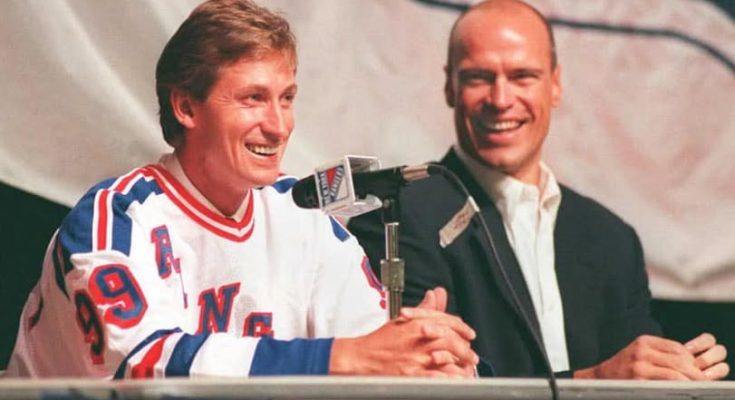On this day in 1996, the hockey world was shaken to its core as Wayne Gretzky—the greatest player in the history of the sport—officially signed with the New York Rangers, reuniting with his longtime friend, teammate, and fellow legend Mark Messier. It wasn’t just a free agent acquisition; it was a seismic moment that blended nostalgia, legacy, and the allure of Madison Square Garden into a spectacle that captivated fans across North America. For many, it marked the final chapter in the story of a generation defined by dynasties, dominance, and undeniable greatness.
Wayne Gretzky’s career up to that point had already been historic. From his explosion onto the NHL scene with the Edmonton Oilers, where he won four Stanley Cups and shattered virtually every offensive record, to his time with the Los Angeles Kings, which elevated hockey’s visibility in the United States, Gretzky had not just changed teams—he had changed the game itself. Yet, as the summer of 1996 rolled around, Gretzky found himself searching for a new home after a brief and bittersweet stint with the St. Louis Blues. Though he still possessed the vision, passing wizardry, and elite hockey IQ that made him a living legend, Gretzky knew his days were numbered, and he wanted to go out on his own terms—with purpose, pride, and most importantly, with a team he believed could contend.
Enter the New York Rangers—a franchise rich with tradition, playing in the world’s most famous arena, and still basking in the afterglow of their 1994 Stanley Cup triumph, which had famously ended a 54-year drought. At the heart of that championship team was Mark Messier, Gretzky’s former running mate in Edmonton and one of the most respected leaders in NHL history. The idea of reuniting with Messier wasn’t just romantic—it made competitive sense. While the Rangers weren’t the juggernaut they were in ‘94, they still had a core of experienced veterans and young talent that made them a viable destination. More than that, the move to New York offered Gretzky the stage he craved to close out his iconic career—not in obscurity, but under the brightest lights in sports.
When the announcement was made, it sent ripples through the hockey world. Gretzky inked a two-year, \$8 million deal that many felt was a bargain, given the name and stature he brought with him. His arrival instantly made the Rangers must-see television, drawing media attention that extended far beyond the hockey sphere. The storylines were tailor-made for legend: The Great One skating once more with Messier, the potential for one last Stanley Cup push, and a curtain call in the most electric market in North American sports. It felt like the script for a Hollywood movie—only it was playing out live in Manhattan.
Gretzky’s time with the Rangers was a masterclass in leadership, humility, and enduring brilliance. Though his scoring had declined from his prime years, he remained a cerebral force on the ice, orchestrating plays with a surgeon’s precision and mentoring younger players with quiet authority. In the 1996–97 season, Gretzky recorded 97 points—still an elite total—proving that while the legs may have slowed, the mind remained as sharp as ever. Perhaps his most memorable performance as a Ranger came during that year’s playoffs, when he tallied a hat trick against the Florida Panthers, reminding everyone that The Great One still had greatness in his grasp.
His partnership with Messier, both on and off the ice, was a key to that success. The two had an almost telepathic connection, honed during their dynasty days in Edmonton, where they dominated the league with a blend of finesse, toughness, and unselfish play. In New York, that chemistry was rekindled, even if only for a brief window. Their leadership set the tone in the locker room, and their shared presence gave the team a psychological edge. Though the Rangers would ultimately fall short of capturing another Stanley Cup during Gretzky’s tenure, the duo’s reunion reignited the franchise’s competitive fire and gave fans memories that would last a lifetime.
Off the ice, Gretzky embraced New York with the same grace and class that had defined his entire career. He was a frequent presence at charity events, an ambassador for the sport, and a living bridge between hockey’s past and its future. His poise in front of the media, his interactions with fans, and his commitment to excellence only deepened his legend. He didn’t just come to New York to play—he came to represent, and he did so with unmatched dignity.
The cultural significance of Gretzky’s move cannot be overstated. By choosing the Rangers, he reinforced the notion that hockey’s greatest icons could thrive in big markets, helping the NHL grow its national footprint. Television ratings climbed. Ticket sales surged. Jerseys flew off the shelves. And young fans, particularly in the New York metropolitan area, were inspired to pick up a stick and dream big. Gretzky’s influence wasn’t confined to the box score—it was felt in rinks across America, in the way the sport was marketed, and in the belief that hockey belonged on the biggest stages.
Moreover, his decision to reunite with Messier spoke volumes about loyalty, friendship, and shared purpose. Their bond, forged in the fires of playoff battles and championship parades, was as genuine as it was powerful. For both men, the reunion was more than nostalgic—it was a chance to lead by example, to chase one more ring, and to remind the world why they were considered two of the most complete players in history. The reverence they shared for each other translated into a palpable sense of unity within the Rangers’ dressing room, where younger players could observe firsthand what greatness really looked like.
Though the fairy tale didn’t end with a Stanley Cup, it did end with the grace befitting of its protagonists. Gretzky would retire in 1999, finishing his career with 2,857 points—a record that still seems untouchable. His final game at Madison Square Garden was a tearful affair, a celebration of a career that had transcended borders, eras, and expectations. The crowd roared, not just for what he had done in a Rangers uniform, but for what he had meant to the sport as a whole. And at his side, as always, was Mark Messier—a teammate, a captain, and a friend.
Looking back, that signing on July 21, 1996, was about more than roster moves or cap space. It was about legacy—about a final act that honored the game, the fans, and the relationships that defined a golden era. It was about two titans of the sport coming together one last time, not to relive the past, but to shape the present. It was about leadership, integrity, and the enduring power of friendship. And for hockey fans everywhere, it was a reminder that while greatness may evolve, its impact never fades.
To this day, the image of Wayne Gretzky in a Rangers jersey skating beside Mark Messier remains one of the most poignant visuals in NHL history. It encapsulates everything the sport aspires to be: elegant, competitive, selfless, and unforgettable. Whether you were in the Garden that night or watching from thousands of miles away, the feeling was the same—you were witnessing history, not just because of the stats or the milestones, but because of the meaning behind them.
In the end, Gretzky’s move to the Rangers was more than just a free agency signing. It was a storybook chapter that gave closure to a remarkable journey and honored the very soul of the sport. And though the years have passed, the resonance of that decision remains, echoing through time like the crisp sound of a puck hitting twine on a cold winter night. On this day in 1996, the world didn’t just get a transaction—it got a reunion, a revival, and a reminder that greatness, when paired with purpose and friendship, is eternal.



